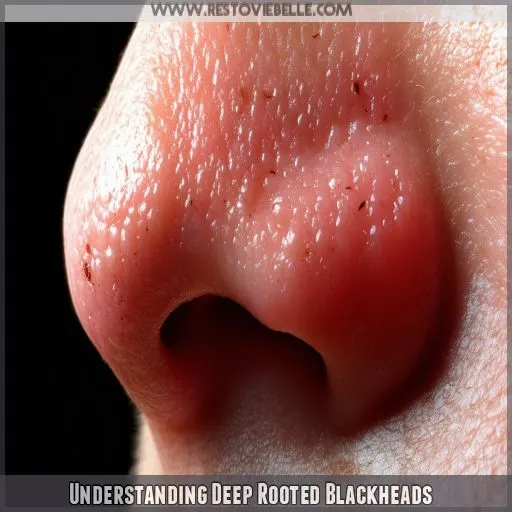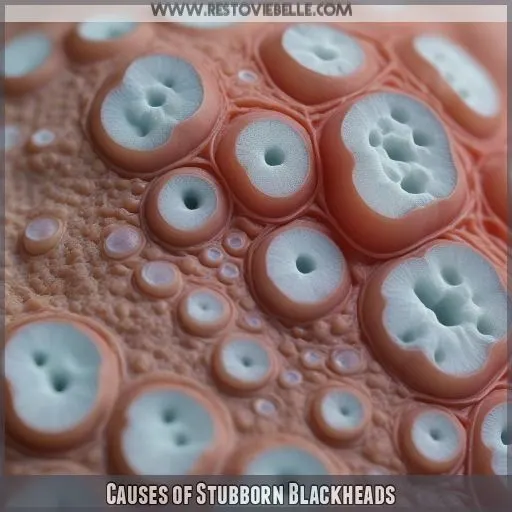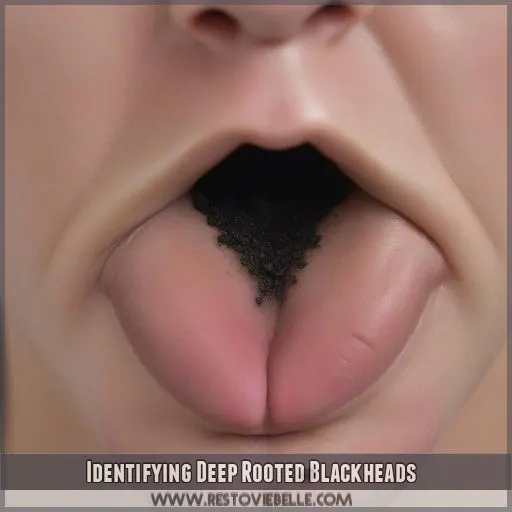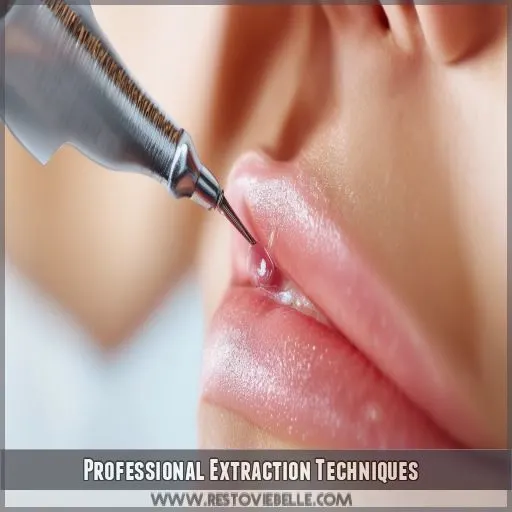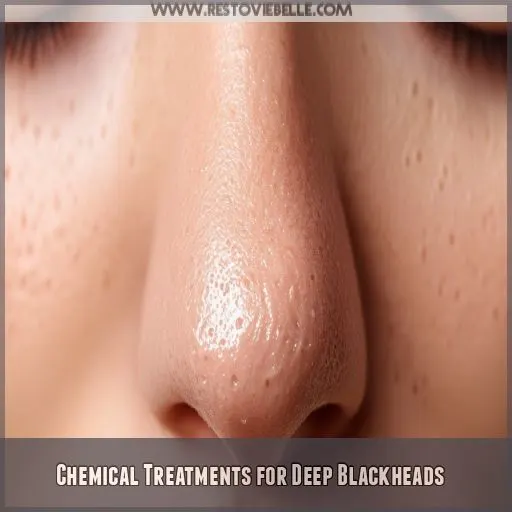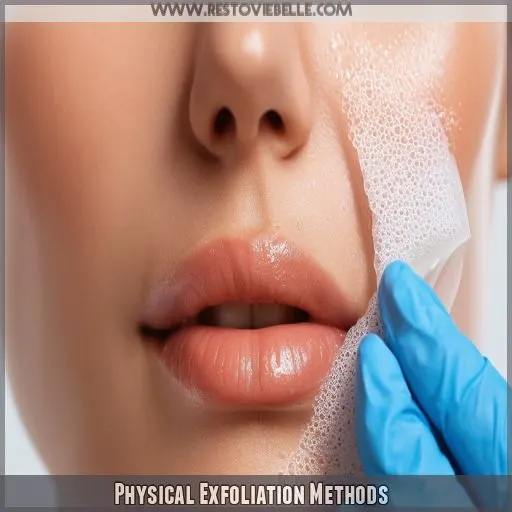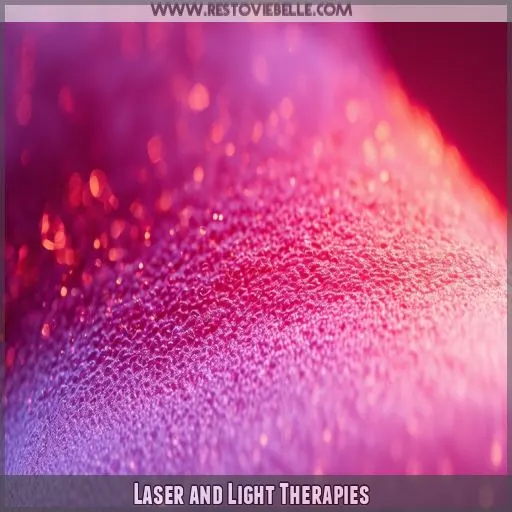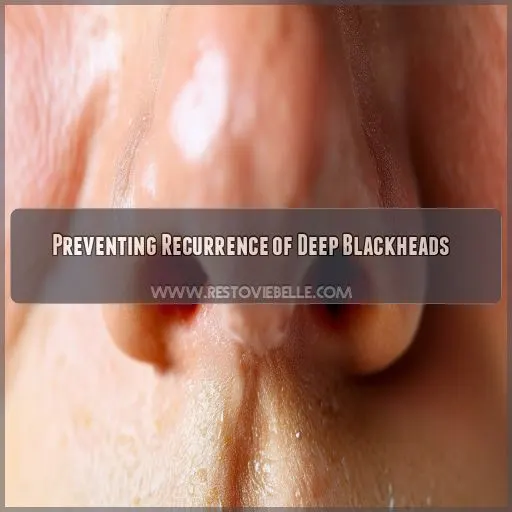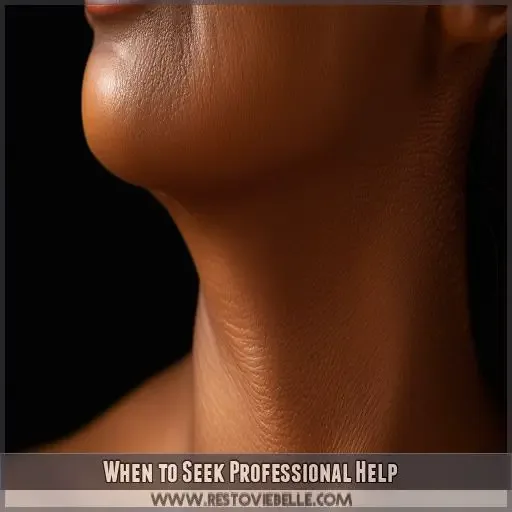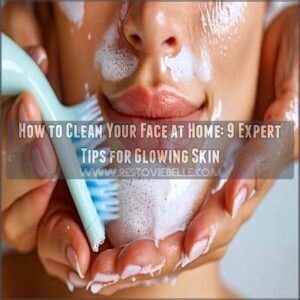This site is supported by our readers. We may earn a commission, at no cost to you, if you purchase through links.
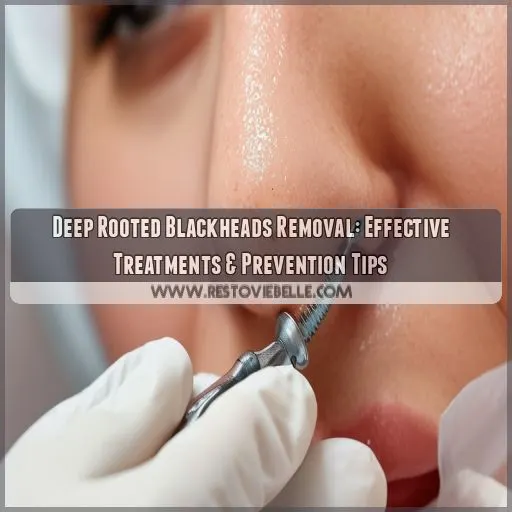 Imagine conquering the most bothersome skin conditions with confidence and poise.
Imagine conquering the most bothersome skin conditions with confidence and poise.
Deep-seated blackheads are the most relentless enemies, filling your pores with far too much sebum and dead cells.
Learn how to professionally and at home remove entrenched blackheads using expert strategies and remedies tailored for results.
Here’s a guide with evidence-based treatments and tips on prevention.
Take control of your skincare and give your skin an unmistakable, healthy glow.
Dive in for a concise professional advisory and take control of your glow today.
Table Of Contents
- Key Takeaways
- Understanding Deep Rooted Blackheads
- Causes of Stubborn Blackheads
- Identifying Deep Rooted Blackheads
- Professional Extraction Techniques
- Chemical Treatments for Deep Blackheads
- Physical Exfoliation Methods
- Laser and Light Therapies
- Preventing Recurrence of Deep Blackheads
- When to Seek Professional Help
- Frequently Asked Questions (FAQs)
- How do you remove deep embedded blackheads?
- How to remove a blackhead that won’t come out?
- Why does my blackhead keep refilling?
- How to remove deep blackheads in the ear?
- How do you remove a blackhead?
- how can a teenager get rid of blackheads?
- Are deep Blackheads hard to remove?
- How do dermatologists treat deep Blackheads?
- What are effective home remedies for blackheads?
- Can diet influence the development of blackheads?
- Are there any risks associated with manual extraction?
- How should I sterilize my skincare tools?
- Do hormonal changes affect blackhead formation?
- Conclusion
Key Takeaways
- Wage war on deep blackheads: Enlist professional extraction techniques, chemical treatments, and physical exfoliation as your weapons in this battle against stubborn blackheads.
- Prevention is your ally: Establish a solid skincare routine, adjust your diet, and make lifestyle changes to keep blackheads at bay. It’s like building a fortress to keep out unwanted guests!
- Don’t be afraid to seek help: If home remedies and your trusty extractor tool fail to conquer those pesky blackheads, don’t hesitate to call in the cavalry – a dermatologist. They’re the skincare superheroes who can save the day!
- Patience is your secret weapon: Removing deep blackheads is like defusing a bomb – it takes patience and precision. Don’t get discouraged if you don’t see results overnight; consistency is key to achieving a clear, radiant complexion.
Understanding Deep Rooted Blackheads
Deep blackheads can be a persistent concern. These pesky blackheads lurk deep within your pores, often making them difficult to remove. They appear as dark, open bumps, primarily due to oil and dead skin cells clogging the pores.
Unlike regular blackheads, deep blackheads lodge more stubbornly within the skin, requiring more effort to extract. They’re particularly common in areas with more sebaceous glands like the face, chest, and back.
Effective treatments involve physical exfoliation, DIY home remedies like honey masks, and diet changes to manage oil production. Managing stress and knowing your family history of acne can also help in preventing these deeply rooted blackheads.
Causes of Stubborn Blackheads
Stubborn blackheads can develop due to excess sebum production, hormonal imbalances, genetic factors, and the buildup of dead skin cells. Understanding these causes is essential for effectively managing and preventing deep-rooted blackheads.
Excess Sebum Production
Excess sebum production often results from overactive sebaceous glands and can clog follicles. Factors include:
- Hormonal regulation
- Diet influence
- Lifestyle impact
- Genetic predisposition
- Oil-rich skin types
Dead Skin Cell Accumulation
Dead skin cell accumulation can worsen clogged follicles, leading to stubborn blackheads. Regular exfoliation helps remove dead skin, preventing pore clogging, promoting skin regeneration, and reducing acne formation. Practice good hygiene.
Hormonal Imbalances
Hormonal changes significantly influence blackhead formation, particularly in young adults. Key triggers include:
- Menstrual cycles
- Pregnancy
- Stress-induced hormone fluctuations
These factors impact both physical health and mood disorders.
Genetic Factors
Genetic factors play a significant role in blackhead development. For instance, your family history/individual gene expression can predispose you to excessive oil production on your face, for which targeted topical treatments alongside professional techniques are therefore required to manage it.
Identifying Deep Rooted Blackheads
Identifying deep-rooted blackheads involves looking for larger, darker spots embedded in the skin, often found on the face, back, and chest. Differentiating them from other skin conditions requires paying attention to their persistent nature and resistance to regular cleansing.
Visual Characteristics
When dealing with deep rooted blackheads, size and shape vary, but they’re typically larger than surface ones. Color is dark due to oxidation. Texture is rougher, often embedded. Identifiable by:
- Consistent dark hue
- Hard texture
- Enlarged size
- Regular extraction necessity
Common Locations
Deep-rooted blackheads commonly appear on body parts such as the face, back, chest, and ears. Teenagers and adults, especially those with a family history of acne, often face this issue. Regular cleansing, steam, home remedies, and over-the-counter (OTC) products help manage them.
Differentiation From Other Skin Conditions
To differentiate deep-rooted blackheads from other skin conditions, consider symptoms like skin discoloration and inflammation. Scarring and skin sensitivity are more common in conditions like acne. For mild cases, home remedies can help, but professional advice is best to prevent suicidal thoughts.
Professional Extraction Techniques
Professional extraction involves a dermatologist using sterilized tools to safely remove deep blackheads, minimizing skin damage. Proper aftercare, such as applying anti-inflammatory products, helps soothe your skin and prevent infections.
Dermatologist Procedures
Consult a dermatologist for the safest and most effective extraction of blackheads. This reduces the formation of scars on your skin while ensuring cleanliness regarding tool usage. Professional extraction improves on situations that are deep-rooted instead of home remedies, reducing negative emotional feelings one derives from constant skin problems.
Sterilization Methods
These are the methods to be used for sterilization to make sure that everything is hygienically clean during blackhead extraction:
- Autoclave methods for tools
- UV light treatment for equipment
- Chemical disinfection using applicable solutions
- Sterilize with steam, then clean further with alcohol wipes.
Aftercare Recommendations
After professional extraction, follow these aftercare instructions:
| Sensitive Skin Care | Avoiding Irritation | Moisturizing Recommendations |
|---|---|---|
| Use gentle cleansers | Avoid touching | Apply non-comedogenic moisturizer |
| Keep area clean | Skip harsh products | Hydrate twice daily |
| Pat skin dry | No makeup for 24 hrs | Opt for soothing ingredients |
| Use lukewarm water | Wear loose clothing | Incorporate hyaluronic acid |
Prioritize sun protection.
Chemical Treatments for Deep Blackheads
This set of deep blackheads requires such chemical treatments as salicylic acid, retinoids, benzoyl peroxide, and azelaic acid. They’re instrumental in attacking clogged pores and thus soothing inflamed areas. Be careful about following the instructions to avoid irritation.
Salicylic Acid
Moving on, salicylic acid works wonders for deep blackhead removal. It exfoliates and unclogs pores, reducing blackheads efficiently. Remember:
- Use the right salicylic acid strength.
- Monitor frequency.
- Watch for side effects.
- Consider alternatives.
Retinoids
Retinoids are powerful for treating deep blackheads. However, watch for retinoid side effects like dryness. Apply small amounts nightly, avoid overuse, and understand potential retinoid purging before significant improvements.
| Side Effects | Application Tips | Dosage Advice |
|---|---|---|
| Dryness | Apply small amounts | Start low, increase gradually |
| Irritation | Use nightly, avoid overuse | Follow prescribed dosage |
| Sensitivity | Be patient with purging | Consult with a dermatologist |
Benzoyl Peroxide
Benzoyl Peroxide is effective for treating blackheads due to its antibacterial properties. However, watch for:
- Skin irritation
- Potential dryness
- Minor peeling
- Redness
- Resistance development over time
Azelaic Acid
Following benzoyl peroxide, consider azelaic acid. This treatment helps by reducing keratin production and killing bacteria. Use typically requires a 10-20% dosage. Be mindful of possible side effects, like skin irritation.
Physical Exfoliation Methods
To tackle deep-rooted blackheads, consider microdermabrasion and ultrasonic skin scrubbing as effective physical exfoliation methods. You can also use clay masks to draw out impurities and keep your pores clean.
Microdermabrasion
Microdermabrasion is an effective way to tackle deep blackheads by exfoliating the skin. It suits various skin types and can be done professionally or with home devices. Compared to ultrasonic scrubbing, its efficacy shines. Aim for routine treatments to maintain results.
Ultrasonic Skin Scrubbing
Ultrasonic skin scrubbing uses ultrasonic technology to lift dead skin and debris from pores, enhancing treatment effectiveness. Compared to microdermabrasion, it’s gentler and safer. Home devices vary in cost but offer convenient options. Be mindful of potential safety concerns.
Clay Masks
Clay masks are excellent for deep blackhead removal. This is how they work:
- Nature ingredients such as kaolin and bentonite detoxify your skin.
- DIY Recipes: All these different recipes could be mixed according to your skin type.
- Proper application techniques ensure maximal skin benefits and effectiveness.
Laser and Light Therapies
Laser and light therapies like Photodynamic Therapy, Intense Pulsed Light (IPL), and Fractional Laser Resurfacing are effective treatments for deep-rooted blackheads. These methods target the underlying causes of blackheads, promoting clearer skin and reducing recurrence.
Photodynamic Therapy
Photodynamic Therapy (PDT) offers an advanced solution for deep blackheads. It combines a photosensitizing agent with light exposure. Effective but pricier, PDT provides swift recovery. Side effects include redness and sensitivity. Compared to other treatments, its effectiveness stands out.
Intense Pulsed Light (IPL)
Deep blackheads can be effectively treated with intense pulsed light (IPL) treatments using broad-spectrum light. Such sessions also rejuvenate skin from vascular and pigmented lesions. Verify:
- Safety precautions are followed
- Treatments done by certified professionals
- Care is given post-treatment
Fractional Laser Resurfacing
Fractional laser resurfacing will pulverize deep blackheads by unclogging the pores. It’s practical, expensive, and requires some resting time, yet it ensures safety if done professionally.
| Aspect | Detail | |
|---|---|---|
| Treatment | Laser Resurfacing | |
| Effectiveness | High | |
| Cost | Expensive | |
| Downtime | Moderate | |
| • | Safety | High |
Preventing Recurrence of Deep Blackheads
Preventing the recurrence of deep blackheads requires a consistent daily skincare routine and careful dietary considerations. Making lifestyle changes like reducing stress and avoiding high carbohydrate foods can also help maintain clearer skin.
Daily Skincare Routine
To prevent deep blackheads, wash your face twice daily using gel-based cleansers with gentle ingredients. Incorporate non-abrasive scrubs and DIY solutions sparingly. Avoid over-cleansing, and keep your skincare routine consistent. Regular oily skin care is essential.
Dietary Considerations
Add low-glycemic-load foods to keep your blood sugar levels relatively low. This might help reduce excess sebum production in your body and skin.
Never over-indulge in milk, as dairy tends to bring about blackheads.
Manage stress: a clear complexion depends on how well you manage stress in your life.
Cleanse regularly with products marked as non-comedogenic to avoid clogged pores and blackheads.
Lifestyle Changes
To prevent deep blackheads, consider these lifestyle changes:
- Stress management: Practice meditation or yoga to keep stress levels in check.
- Sleep optimization: Aim for 7-8 hours of restful sleep nightly.
- Dietary modifications: Eat a balanced diet to support healthy skin.
When to Seek Professional Help
If, however, your deep-seated blackheads are unrelenting despite the thorough measures you take, then it’s time to seek help from a professional. Go to a dermatologist who’ll apply specialized extraction techniques with good sterilization to safeguard your skin with minimal damage.
Some of the persistent blackheads may need prescription treatments such as retinoids or vital topical antibiotic medication to be fought effectively. You could always discuss other advanced treatment options to enhance their effectiveness, such as laser therapy or chemical peels.
Consult with a dermatologist, and this shall help to personalize a routine for you, inclusive of measures to get you immediate relief and prevent future recurrence. Let blackheads no longer dictate your confidence—and know that the proper guidance does make all the difference. To seek help isn’t defeat; it’s a wise step towards clearer skin.
Frequently Asked Questions (FAQs)
How do you remove deep embedded blackheads?
Remove deep embedded blackheads by using a sterilized extractor tool gently, considering topical treatments like retinoids or salicylic acid, and seeking professional help for manual extraction if needed. Avoid squeezing to prevent skin damage.
How to remove a blackhead that won’t come out?
Like a stubborn tree root, a blackhead that won’t budge requires patience. Use a warm compress to soften the skin and try gentle extraction again. If it persists, consult a dermatologist to avoid damage.
Why does my blackhead keep refilling?
Your blackhead keeps refilling because excess sebum and dead skin cells continue to clog the pore. Persistent triggers like hormonal changes, stress, and improper cleansing can exacerbate this issue, necessitating ongoing management and prevention strategies.
How to remove deep blackheads in the ear?
To remove deep blackheads in the ear, gently sterilize an extractor tool, apply light pressure on the blackhead with the loop, and perform a sweeping motion. Repeat if needed and disinfect the tool between uses.
How do you remove a blackhead?
Picture your blackheads as tiny volcanoes ready to erupt. Gently cleanse your skin, steam to open pores, then use a sterilized extractor tool to coax out the plug. Soothe with anti-inflammatory products to prevent irritation.
how can a teenager get rid of blackheads?
To get rid of blackheads, cleanse your face twice daily with a gel-based cleanser, exfoliate gently, steam and use a clay mask, sterilize and use an extractor tool, and avoid squeezing.
Are deep Blackheads hard to remove?
Yes, deep blackheads can be hard to remove because they form deep in the skin. Using topical treatments, proper exfoliation, and sometimes professional extraction can help in effectively removing them without causing damage.
How do dermatologists treat deep Blackheads?
You’ll find dermatologists treat deep blackheads using manual extraction with sterilized tools, prescription retinoids, topical antibiotics, or chemical peels. For severe cases, oral antibiotics may be prescribed to manage underlying issues contributing to blackhead formation.
What are effective home remedies for blackheads?
Channel your inner apothecary! Use tea tree oil, jojoba oil, honey, or aloe vera to combat blackheads. Apply these natural remedies to cleanse and soothe your skin, reducing blockages and promoting a clearer complexion.
Can diet influence the development of blackheads?
Yes, your diet can influence blackhead development. Reducing high-glycemic foods and milk intake helps manage sebum production, minimizing clogged pores and blackheads. Maintaining a balanced diet supports healthier skin overall.
Are there any risks associated with manual extraction?
Sure, go ahead and play dermatologist at your own risk! Manual extraction can cause skin damage, scarring, and infection if not done correctly. It’s like trying to defuse a bomb without training – proceed with caution!
How should I sterilize my skincare tools?
Sterilize your skincare tools by washing them in soap and water, then dipping them in 70% rubbing alcohol for 10 minutes; afterward, let them air-dry on a clean cloth, and make sure they’re scorched when used.
Do hormonal changes affect blackhead formation?
Yes, hormonal changes can affect blackhead formation. During puberty, menstruation, pregnancy, or stress, your body often produces more sebum, which can lead to clogged pores and blackhead formation. Hormonal fluctuations are a key contributor.
Conclusion
Tackling deep-rooted blackheads can feel like climbing a mountain, but with the right tools and strategies, you can reach the summit.
Utilize professional extraction techniques, chemical treatments, and physical exfoliation to manage and remove stubborn blackheads.
Prevent recurrence with a solid skincare routine, dietary adjustments, and lifestyle changes.
When in doubt, seek professional help.

